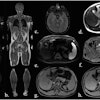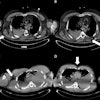Researchers in Germany produced excellent virtual colonoscopy results on a 64-slice CT scanner using thin-section imaging, dose modulation, and primary 3D interpretation.
In a group of asymptomatic screening subjects who underwent both virtual and conventional colonoscopy on the same day, virtual colonoscopy was sensitive and specific for the detection of polyps of all sizes. Conventional colonoscopy had a slight edge in diminutive polyps, but virtual colonoscopy did a little better with the larger lesions.
The ongoing Munich Colorectal Cancer Prevention Trial aims to compare sensitivity and specificity for adenoma detection in 64-slice CT to that of optical colonoscopy in asymptomatic screening patients.
Lead investigator Dr. Anno Graser from the University of Munich discussed results from the first 300 patients at the 2006 RSNA meeting in Chicago.
All subjects underwent same-day CT colonography (CTC or VC) and optical colonoscopy after complete bowel cleansing, Graser said. Room-air insufflation was used on the first 120 patients, and after installing an automated insufflator (ProtoCO2l, E-Z-EM, Lake Success, NY), the remaining patients were insufflated using CO2 gas.
Prone and supine scanning was performed on a Sensation 64 multidetector-row CT (MDCT) scanner (Siemens Medical Solutions, Erlangen, Germany) using 0.6-mm collimation and 120 kVp; online dose modulation was used at 40 reference mAs for the supine scans and 40 reference mAs for prone scanning. The patient dose was calculated for all subjects. Primary 3D viewing ("unfolded view" Siemens syngo Colon) was used to interpret the findings.
"All scans were interpreted by an expert reader with more than 700 cases, and the results were compared to same-day colonoscopy using segmental unblinding for all six bowel segments," Graser said. "Same-day reference colonoscopy was performed using segmental unblinding in a method described by Perry Pickhardt and colleagues.... We calculated (VC's) per-polyp and per-patient sensitivity by all size groups."
In all, the group found 236 polyps in 112 patients, including 138 adenomatous and 88 hyperplastic polyps. There were 70 polyps 5 mm or smaller. A total of 145 were adenomatous, including 33 small lesions, 86 medium lesions, and 26 lesions 1 cm or larger.
"As to the distribution of those adenomas and hyperplastic polyps within the colon, I would tell you to look at two things," Graser said. "First, if you look at the small ones, you see about 50% of the small polyps turned out to be adenomatous in pathology. Second, if we had only performed sigmoidoscopy, we would have missed 133 polyps that were located further up from the rectum than the sigmoid colon."
The sensitivity of virtual colonoscopy was 96% (23/24) for large adenomas, 92.1% (35/38) for intermediate (6-9 mm) adenomas, and 78.9% (60/76) for small (< 5 mm) adenomas, respectively. Per-patient sensitivities were 100%, 98%, and 80%, respectively; specificities were 100%, 96.7%, and 92.3% for large, intermediate, and small adenomas, respectively.
Optical colonoscopy missed one large, two intermediate, and eight small polyps (sensitivities 96%, 95%, and 89.5%, respectively), while VC missed one 10-mm polyp.
"Per-polyp sensitivity in our trial up to now shows very good results for medium and large polyps for (VC)," Graser said. "Optical colonoscopy does pick up a larger number of those less-than-5-mm small polyps than does (VC) -- with overall sensitivity 81% (VC) and 91% for optical. But if you look at the adenomas, (VC's per-patient) sensitivity for small lesions (98%) is a little bit higher than for the medium, which was 100%, whereas optical colonoscopy missed one large polyp and (VC) missed one large polyp," he said.
The median effective radiation dose was 4.2 mSv (range of 3.5-4.9 mSv).
"High-resolution CT colonography using 64-slice MDCT shows high sensitivity for the detection of colorectal polyps," Graser concluded. "I believe, and everybody in this room believes, there is room for CTC in colorectal cancer screening."
By Eric Barnes
AuntMinnie.com staff writer
January 17, 2006
Related Reading
VC software highlights colon's unseen areas, June 16, 2006
CAD aids polyp detection in 64-slice study, May 12, 2006
'Filet view' VC software slices reading time, October 6, 2005
Z-axis modulation cuts VC dose, keeps image quality high, April 12, 2005
Copyright © 2007 AuntMinnie.com

















